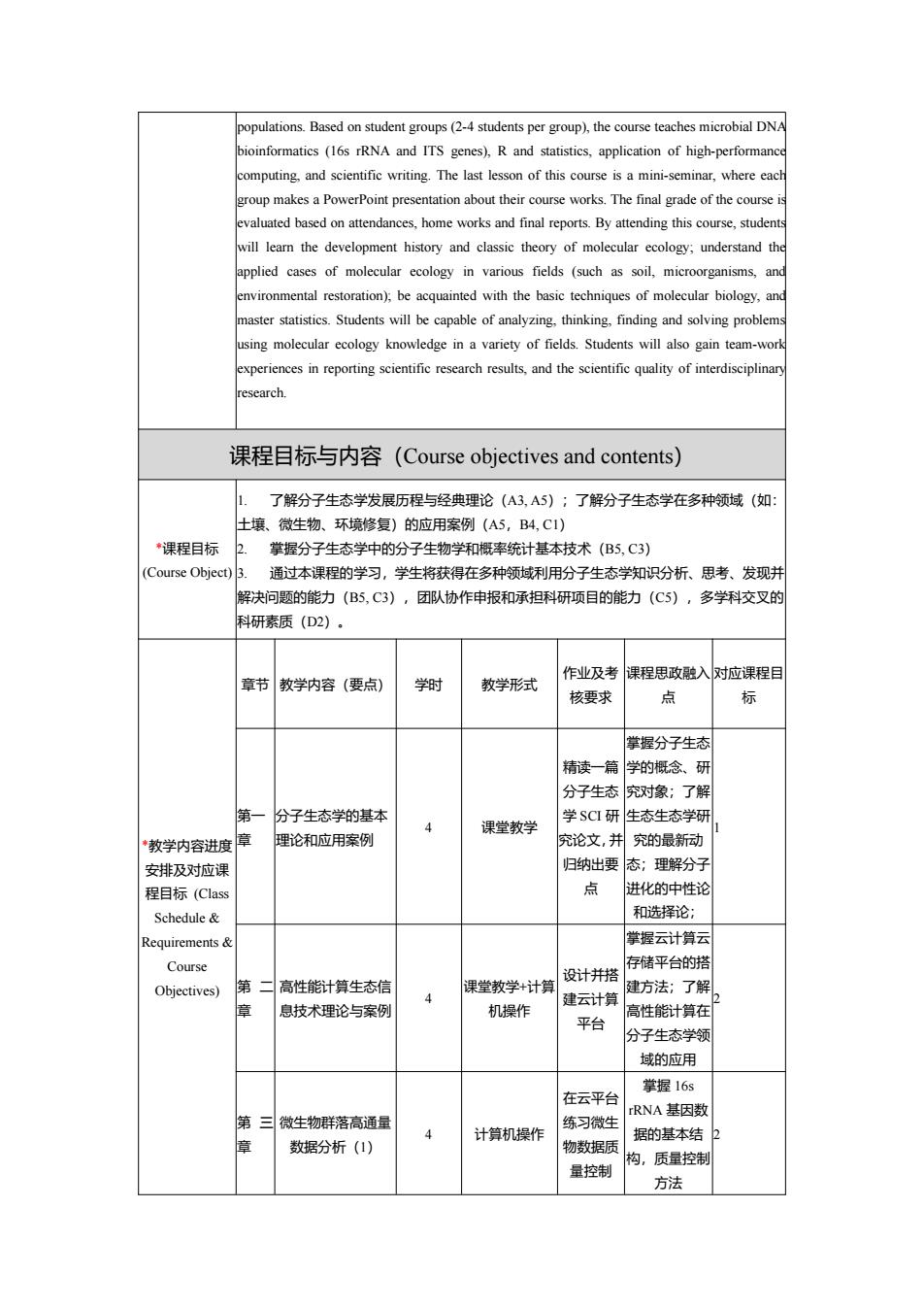正在加载图片...

Based n student group (students per group)the microbial DN matics (16s rRNA and ITS genes).R andst atistics,application of high-performa computing,and scientific writing.The last lesson of this course is a mini-seminar,where eroup makes a PowerPoint presentation about their course works.The final grade of the course evaluated based on attendances.home works and final reports.By attending this course,studen will leamn the development history and classic theory of molecular ecology:understand th applied cases of molecular ccology in various fields (such as soil,microorgar nmental resto )the basic tchniques of molecular biology.an master statistics.Students will be capable of analyzing.thinking.finding and oving probler using molecular eoloy knowledge in a variety of fields Students will also gain team-w experiences in reporting scientific research results.and the scientifie quality of interdiscipling 课程目标与内容(Course objectives and contents) 1.了解分子生态学发展历程与经典理论(A3,A5):了解分子生态学在多种领域(如: 土壤、微生物、环境修复)的应用案例(A5,B4,C1) *课程目标 掌握分子生态学中的分子生物学和概率统计基本技术(B5.C3) Course Object) 过本 程的学习,学生将获得在多种领域利用盼子生态学知识分析、思考、发现 解决问题的能力(B5,C3),团队协作申报和承担科研项目的能力(C5),多学科交叉的 科研素质(D2), 章节教学内容(要点) 教学形式 作业及 课程思政融 对应课程目 核要求 点 标 掌握分子生表 精读一篇学的概念。研 分子生态究对像:了解 第 分子生态学的基本 4 课堂教学 学sC研生态生态 “教学内容进度草 理论和应用案例 究论文, 究的最新动 安及过应注 归纳出要态:理解分 程且标(C 点 进化的中性沙 Schedule 和选择论: Requirements 学握云计算云 Course 存储平台的格 0 bjectives))第二高性能i计算生态信 设计并招 4 课堂教学+计算 建云计道 健方法:了解 息技术理论与案例 机操作 高性能计算在 平台 分子生态学 域的应用 掌握16s 在云平台 rRNA其因数 筑三微生物姓装高通量 练习微生 4 计算机操作 据的基本结 数据分析(1) 物辉活 量控制 构。质量控 方法populations. Based on student groups (2-4 students per group), the course teaches microbial DNA bioinformatics (16s rRNA and ITS genes), R and statistics, application of high-performance computing, and scientific writing. The last lesson of this course is a mini-seminar, where each group makes a PowerPoint presentation about their course works. The final grade of the course is evaluated based on attendances, home works and final reports. By attending this course, students will learn the development history and classic theory of molecular ecology; understand the applied cases of molecular ecology in various fields (such as soil, microorganisms, and environmental restoration); be acquainted with the basic techniques of molecular biology, and master statistics. Students will be capable of analyzing, thinking, finding and solving problems using molecular ecology knowledge in a variety of fields. Students will also gain team-work experiences in reporting scientific research results, and the scientific quality of interdisciplinary research. 课程目标与内容(Course objectives and contents) *课程目标 (Course Object) 1. 了解分子生态学发展历程与经典理论(A3, A5);了解分子生态学在多种领域(如: 土壤、微生物、环境修复)的应用案例(A5,B4, C1) 2. 掌握分子生态学中的分子生物学和概率统计基本技术(B5, C3) 3. 通过本课程的学习,学生将获得在多种领域利用分子生态学知识分析、思考、发现并 解决问题的能力(B5, C3),团队协作申报和承担科研项目的能力(C5),多学科交叉的 科研素质(D2)。 *教学内容进度 安排及对应课 程目标 (Class Schedule & Requirements & Course Objectives) 章节 教学内容(要点) 学时 教学形式 作业及考 核要求 课程思政融入 点 对应课程目 标 第一 章 分子生态学的基本 理论和应用案例 4 课堂教学 精读一篇 分子生态 学 SCI 研 究论文,并 归纳出要 点 掌握分子生态 学的概念、研 究对象;了解 生态生态学研 究的最新动 态;理解分子 进化的中性论 和选择论; 1 第 二 章 高性能计算生态信 息技术理论与案例 4 课堂教学+计算 机操作 设计并搭 建云计算 平台 掌握云计算云 存储平台的搭 建方法;了解 高性能计算在 分子生态学领 域的应用 2 第 三 章 微生物群落高通量 数据分析(1) 4 计算机操作 在云平台 练习微生 物数据质 量控制 掌握 16s rRNA 基因数 据的基本结 构,质量控制 方法 2